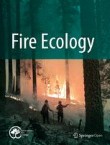Fire Ecology is the official journal of the Association for Fire Ecology.
Simulation Approaches for Burn Severity Estimation Using Remotely Sensed Images
Traditional field-based methods for estimating burn severity are time-consuming, labour intensive and normally limited in spatial extent. Remotely sensed data provide a means to estimate severity levels across...
